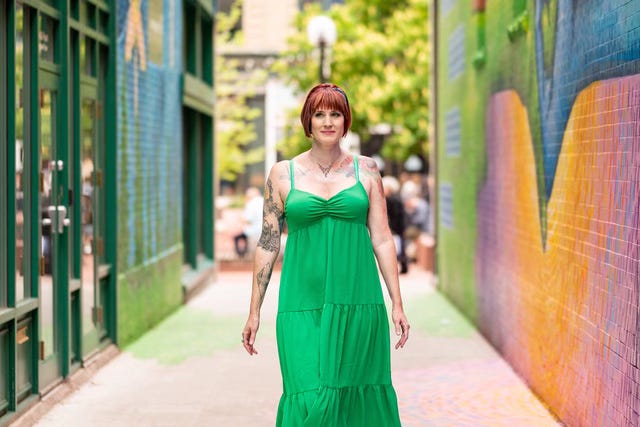
is a writer, producer, podcaster, and single mom. She facilitates writing workshops and groups for midlife women at MidCircle, produces the live storytelling show Listen To Your Mother Boulder, and just finished second-round revisions on a memoir. She co-hosts the Mother Plus Podcast, a show for moms with ADHD, and occasionally does stand-up comedy, which is just as terrifying as you might expect. Steph teaches voice lessons to adolescent girls, which has quite a bit in common with teaching writing to midlife women—guiding girls and women to find and use their voices is her biggest passion in life. She recently launched a call for anonymous submissions for Redacted: What Divorced Women Aren’t Telling You. Steph’s work has been published in O Magazine, The Washington Post, Cosmopolitan.com, Brain, Child Magazine, Motherwell, The Huffington Post, Mutha Magazine, The Belladonna Comedy, the Chicken Soup for the Soul series, and other places.
1. Why Substack?
I was sort of a late-stage original blogger in the early 2010s, and while I loved it for a time, the evolution and decline of the blogging world was dizzying. I missed having a regular place where I shared my writing, but blogging had become isolating (after its apex in which it could be quite time-consuming, what with all the networking) and I felt like I was throwing my words into the void. Plus, WordPress became a nightmare for this non-tech writer, and I couldn’t keep up. When I switched to Substack three years ago, it felt so easy and intuitive. And the platform itself makes it so easy to connect with other writers, get recommendations, and actually get eyes on your writing. I loved it; it combined my blog and newsletter effortlessly and I found I was much less resistant to writing regularly.
2. How long did it take you to find your groove?
I was sort of half-hearted with it for the first 6-12 months, honestly. I also decided to rebrand after the first year—I was no longer writing about motherhood the way I used to. It was time to really refine my focus: I had hit midlife, I was on the cusp of an ADHD diagnosis, and then my life changes really affirmed that shift. A year after I started my column, I decided to start taking it more seriously and re-commit to writing weekly. This was right around the time I quit my job in order to write the memoir I had been tossing around for a decade—that’s the point when things really began to click. Once I invested in the process, after sort of dabbling for a year, I got into a good flow. I kept myself accountable by sharing memoir excerpts or progress, and then I got a divorce—unexpectedly, explosively. And from that moment on, Substack became a lifeline.
3. How has it changed you?
What a natural segue! As I completed the first draft of my memoir, I had a realization that I added to the final chapter: “I wrote my way out of one life and into another.” While that is absolutely true, and writing the manuscript itself was utterly transformative, Substack also played a huge role. It was the place I shared updates on my ADHD diagnosis, my book, my divorce, perimenopause, my creative endeavors, my grief, my rage. I wrote weekly, and as I did, I began to understand myself better. As a beautiful bonus, my community showed up to rally around me, reading, commenting, sharing, and connecting. I hadn’t realized it until you asked the question, but Substack really did change my life.
4. What mistakes have you made?
Well, rebranding springs to mind, but honestly, I don’t consider the need to rebrand as a “mistake” per se; I think Substack makes it easy to pivot, to evolve, to reinvent yourself, to start again. But I do think it would have been easier to “start as I meant to go on,” although I certainly did not intend to become a late diagnosed neurodivergent single mother when I began it. 😉I do think that when I added the concept of “bonus content” that I became unable to follow through with—extra series, paywall features—I should probably have thought that through. Your next question touches on that a bit, but I think I didn’t really have a clear vision of what my column wanted to be when it grew up. Maybe it still doesn’t.
5. To pay or not to pay?
I say, “Go for it!” When I opened up the paid subscriber option, I was blown away by the family, friends, and readers who paid money simply to support my work. Having a robust paid subscriber section has not been a priority for me, so honestly, the paid feature is more a “good karma”/NPR reader support model at the moment. As I said, I never had a clear idea of how to really develop a paid subscriber bonus section, or what I wanted to (or was capable of) follow through with, so that is still kind of a work in progress. Mine is a fairly passive model for paid subscribers at the moment; perhaps I’ll develop it in months and years to come with growth, but right now, I’m just grateful for the support of readers. Writing for free can be rough.
6. What artistic and technical choices have you made?
I’ve changed my aesthetic, cover photo etc alongside my rebranded content, which has been fun. I’ve learned to play with headings, to break up text with quote blocks and bold, to add images in interesting places, to use buttons more than I had before. Substack is such a fun playground for artistic and technical exploration, especially for those of us who, as I mentioned, may not be website geniuses. It’s just such an intuitive, user-friendly platform and I love trying new things.
7. What’s been the effect on your writing?
I think it has sharpened it. It’s made me really think about which word darlings that I’m. . .not willing to murder, but who may need to sit this week out, if that makes sense. I’ve learned how to revise myself a bit more relentlessly. I’ve also become a less apologetic, more vulnerable, more focused writer. Substack has galvanized the things I feel passionately about and helped me connect with others. That’s kept me focused on my purpose. I think my messaging is clearer, and I think I’ve really honed in on my target audience in ways I hadn’t in the past. In some ways, I’m both more refined and less—more polished, concise content (which may make readers laugh, as brevity is still not my strong suit) but it’s also helped me lose a filter of politeness that the patriarchy has beaten out of me. Substack was also the impetus for me creating my call for submissions for my anonymous divorce publication, Redacted, which I’ll launch on Substack this summer with a print anthology to follow next year.
8. In it for the long haul?
Absolutely. I don’t think I could quit if I tried. And now with Redacted around the corner, I’d say I’m happily settled into Substack for the foreseeable future. I love it here. It feels like home.








I wrote myself out of one life and into another. Love that!
The Magic that IS Substack: "As a beautiful bonus, my community showed up to rally around me, reading, commenting, sharing, and connecting. I hadn’t realized it until you asked the question, but Substack really did change my life."